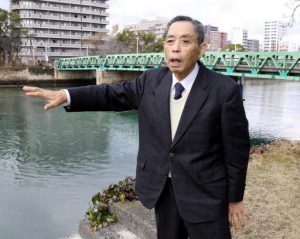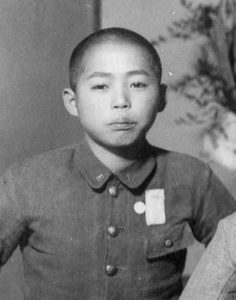Survivors’ Stories: Nobuyasu Nuibe, 91, Aki Ward, Hiroshima
Feb. 1, 2021
by Kyoko Niiyama, Staff Writer
Nobuyasu Nuibe, 91, had a brother, Kazuhiko, three years younger than he who was killed in the atomic bombing. Two days after the atomic bomb was dropped, Kazuhiko’s body was found next to the Honkawa Bridge, located in Hiroshima’s Naka Ward. Mr. Nuibe continues to write deliberately about memories of his brother and about his death.
At that time, the two brothers were third- and first-year students studying electricity at the Hiroshima Prefectural Hiroshima Technical School (now Hiroshima Prefectural Hiroshima Technical High School). Mr. Nuibe was 15 then, and there were a total of six children in the family. Mr. Nuibe and Kazuhiko were close to each other in age, which seemed to lead to frequent quarrels.
On the morning of August 6, 1945, as their mother Takino was preparing Kazuhiko’s box lunch, he started complaining that he did not want to go to school. He was supposed to help tear down buildings to create fire lanes as a mobilized student in the war effort. “You should behave like a real Japanese man,” Takino said. Scolded by his mother in that way, Kazuhiko left home in a sullen mood. “Come to think of it, that was the first and last time I heard my brother say something selfish,” Mr. Nuibe has indicated.
Mr. Nuibe left home for the Hiroshima Machinery Works of Mitsubishi Heavy Industries in Minamikanon-machi (now part of Nishi Ward), where he was scheduled to work as a mobilized student. Right after he and his classmates had gathered inside, there was an intense flash outside, and they immediately hid under the desks. The factory was located about three kilometers from the hypocenter. After things had quieted down, they went outside and witnessed a mushroom cloud billowing up in the sky.
The uninjured Mr. Nuibe headed for his home in the town of Saka-cho. The areas he traveled through were devastated. He heard someone calling for help from under the eaves of a collapsed house. But with fire closing in, he was not able to anything. He somehow managed to reach home, but his brother was not there.
The following day, Mr. Nuibe left home alone to go to their high school in Senda-machi (now part of Naka Ward). Hearing that first-year students had been working in the Nakajima-shinmachi area, he headed out in that direction. Along the way, as he approached the area where his brother had been working, he experienced a sudden increase in the number of corpses.
When he reached Honkawa Bridge, he found some lunch boxes collected on the riverbank. On the very top was an aluminum lunch box that seemed familiar to him. He cautiously opened the box and found that the food was still there untouched.
The next day, he and his parents set out to search for Kazuhiko. Suddenly his mother cried out, “My child!” Among the bodies pulled up by soldiers using fire hooks from step-like stones on the river embankment was Kazuhiko. His hair and clothes had been burned by the bomb’s thermal rays, and his face was swollen. His brother’s appearance altered beyond recognition, Mr. Nuibe could not believe it was him.
When he and his father held up the body, they found his name “Kazu Nuibe” written on the unburned gaiters reaching his knees. Mr. Nuibe could not stop crying. They had Kazuhiko’s body cremated there and brought his ashes home. A total of 192 first-year students at the high school, including Kazuhiko, were killed as they worked to tear down buildings.
After the war, Takino placed Kazuhiko’s photograph in a cupboard and every day offered three meals of the same food the family was eating. “She might have felt regret that she made him go to work that day against his will,” Mr. Nuibe has explained.
After graduating from high school, Mr. Nuibe began working for the Chugoku Telecommunications Bureau (now NTT West) in 1949. He married at the age of 29 and raised two children. As an engineer, he was engaged in railroad and civil-engineering projects for 40 years. Since his retirement at the age of 65, he has more frequently allowed himself to remember his brother.
“I want to leave proof that he lived,” is something he wrote in a memoir about his brother, copies of which he donated to the Hiroshima Peace Memorial Museum and other facilities. He keeps his own copy at home. “I hope my grandchildren and great grandchildren will read it someday and understand the horror of nuclear weapons.”
(Originally published on February 1, 2021)
Body found near brother’s lunch box
Unwillingness to go to school Kazuhiko’s first and last expression of selfishness
Nobuyasu Nuibe, 91, had a brother, Kazuhiko, three years younger than he who was killed in the atomic bombing. Two days after the atomic bomb was dropped, Kazuhiko’s body was found next to the Honkawa Bridge, located in Hiroshima’s Naka Ward. Mr. Nuibe continues to write deliberately about memories of his brother and about his death.
At that time, the two brothers were third- and first-year students studying electricity at the Hiroshima Prefectural Hiroshima Technical School (now Hiroshima Prefectural Hiroshima Technical High School). Mr. Nuibe was 15 then, and there were a total of six children in the family. Mr. Nuibe and Kazuhiko were close to each other in age, which seemed to lead to frequent quarrels.
On the morning of August 6, 1945, as their mother Takino was preparing Kazuhiko’s box lunch, he started complaining that he did not want to go to school. He was supposed to help tear down buildings to create fire lanes as a mobilized student in the war effort. “You should behave like a real Japanese man,” Takino said. Scolded by his mother in that way, Kazuhiko left home in a sullen mood. “Come to think of it, that was the first and last time I heard my brother say something selfish,” Mr. Nuibe has indicated.
Mr. Nuibe left home for the Hiroshima Machinery Works of Mitsubishi Heavy Industries in Minamikanon-machi (now part of Nishi Ward), where he was scheduled to work as a mobilized student. Right after he and his classmates had gathered inside, there was an intense flash outside, and they immediately hid under the desks. The factory was located about three kilometers from the hypocenter. After things had quieted down, they went outside and witnessed a mushroom cloud billowing up in the sky.
The uninjured Mr. Nuibe headed for his home in the town of Saka-cho. The areas he traveled through were devastated. He heard someone calling for help from under the eaves of a collapsed house. But with fire closing in, he was not able to anything. He somehow managed to reach home, but his brother was not there.
The following day, Mr. Nuibe left home alone to go to their high school in Senda-machi (now part of Naka Ward). Hearing that first-year students had been working in the Nakajima-shinmachi area, he headed out in that direction. Along the way, as he approached the area where his brother had been working, he experienced a sudden increase in the number of corpses.
When he reached Honkawa Bridge, he found some lunch boxes collected on the riverbank. On the very top was an aluminum lunch box that seemed familiar to him. He cautiously opened the box and found that the food was still there untouched.
The next day, he and his parents set out to search for Kazuhiko. Suddenly his mother cried out, “My child!” Among the bodies pulled up by soldiers using fire hooks from step-like stones on the river embankment was Kazuhiko. His hair and clothes had been burned by the bomb’s thermal rays, and his face was swollen. His brother’s appearance altered beyond recognition, Mr. Nuibe could not believe it was him.
When he and his father held up the body, they found his name “Kazu Nuibe” written on the unburned gaiters reaching his knees. Mr. Nuibe could not stop crying. They had Kazuhiko’s body cremated there and brought his ashes home. A total of 192 first-year students at the high school, including Kazuhiko, were killed as they worked to tear down buildings.
After the war, Takino placed Kazuhiko’s photograph in a cupboard and every day offered three meals of the same food the family was eating. “She might have felt regret that she made him go to work that day against his will,” Mr. Nuibe has explained.
After graduating from high school, Mr. Nuibe began working for the Chugoku Telecommunications Bureau (now NTT West) in 1949. He married at the age of 29 and raised two children. As an engineer, he was engaged in railroad and civil-engineering projects for 40 years. Since his retirement at the age of 65, he has more frequently allowed himself to remember his brother.
“I want to leave proof that he lived,” is something he wrote in a memoir about his brother, copies of which he donated to the Hiroshima Peace Memorial Museum and other facilities. He keeps his own copy at home. “I hope my grandchildren and great grandchildren will read it someday and understand the horror of nuclear weapons.”
(Originally published on February 1, 2021)









